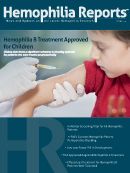Recombinant FVIII Fc Under Review in Europe
A recombinant FVIII Fc fusion protein product candidate for the treatment of hemophilia A is under review in Europe.

The European Medicines Agency (EMA) has validated the Marketing Authorization Application (MAA) of a recombinant factor VIII Fc fusion protein product candidate for the treatment of hemophilia A.
With the validation of the MAA, the EMA’s review process has been initiated for the review of a new drug, European trade name Elocta, produced by Biogen Idec and Swedish Orphan Biovitrum (Sobi). Elocta is known in the US, Canada, and Australia as Eloctate, and is an antihemophilic factor Fc fusion protein. It is advertised as the first recombinant clotting FVIII therapy with prolonged circulation to provide protection from bleeding episodes with the potential for an extended interval between prophylactic injections.
“The validation of Elocta’s application by the EMA is an important step toward bringing this innovative treatment to people with hemophilia A in Europe,” Douglas E. Williams, PhD, executive vice president of Research and Development at Biogen Idec, said in a press release. “Elocta has the potential to protect against bleeding episodes while helping to address the challenge of frequent injections.”
The drug was developed by fusing FVIII to the Fc portion of immunoglobulin G subclass 1 (IgG1), a protein commonly found in the body. The researchers believe the naturally occurring pathways that IgG1 provides enable Elocta to prolong the time therapy remains in the body.
The decision to initiate the process stemmed from a Phase 3 clinical trial called A-LONG that evaluated the efficacy, safety, and pharmacokinetics of rFVIIIFc in males aged 12 years or older with severe hemophilia A. The study enrolled 165 treatment naïve adolescent and adult males with hemophilia A. The researchers of the study observed individualized and weekly prophylaxis to reduce or prevent bleeding episodes, and on demand dosing to treat bleeding episodes. Participants in the individualized branch received twice weekly doses of 65 IU/kg/week. Every 3-5 days, adjustments to the dosing intervals and dose were made to control breakthrough bleeding episodes.
A Phase 3 study called A-LONG Kids evaluated the same primary endpoints in children aged 12 or younger with hemophilia A. In this study, 71 boys with at least 50 prior exposure days to FVIII therapies were observed.
“Sobi and Biogen Idec are committed to addressing significant medical needs in the global hemophilia community,” Birgitte Volck, MD, PhD, senior vice president development and chief medical officer of Sobi, continued in the statement. “We’re working collaboratively to deliver innovative medicines that have the potential to change the way hemophilia A is treated.”
